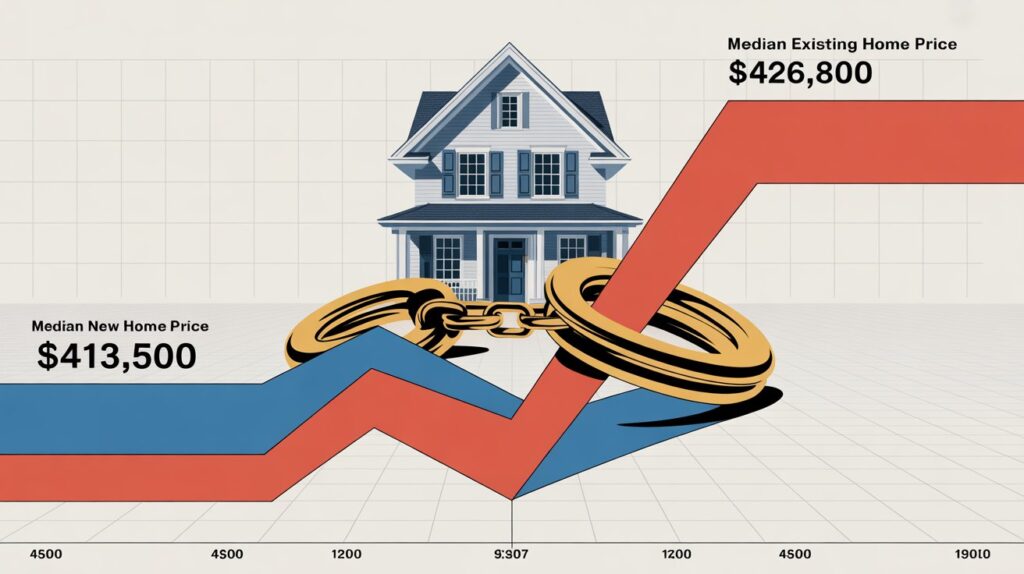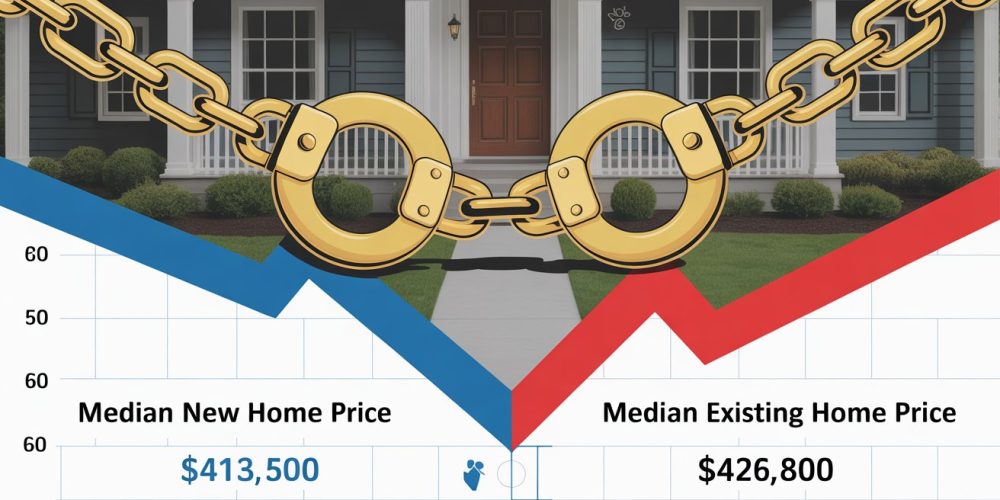
The Tectonic Shift in the American Housing Market
The year 2025 has cemented its place in real estate history with an unprecedented economic reality: the median price of new single-family homes has definitively fallen below that of existing single-family homes across the United States. This is not a cyclical dip but a structural inversion, a dramatic outcome of monetary policy, a strained US economy 2025, and calculated builder strategies designed to navigate the 2025 affordability crisis.
The latest data validates this historic housing anomaly. The median sale price for an existing single-family home stood stubbornly high at $426,800 in Q3 2025, according to National Association of Realtors (NAR) figures.1 Simultaneously, the median price for a new single-family home registered $413,500 (U.S. Census Bureau, August 2025). This $13,300 difference represents a complete collapse of the traditional pricing hierarchy and highlights the desperate measures required to sustain transactional volume in a market choked by prohibitive 30-year fixed mortgage rates.
This 5000-word data-driven analysis delves into the ten core drivers, examining specific facts and figures concerning mortgage rates 2025, real wage growth, US population dynamics, and builder incentives that have created this defining moment. Understanding this inversion is key to identifying the future path of US housing market shifts and the evolving cost of ownership.
The Macroeconomic Chokepoint – Interest Rates, GDP, and Affordability
The foundation of the median home price inversion is the high cost of capital imposed by the Federal Reserve’s battle against persistent inflation.
1. The Weaponization of the 30-Year Fixed Mortgage Rate
The single most impactful variable is the 30-year fixed mortgage rate, which has stabilized around 6.31% (MBA, October 2025). This persistent elevation represents a historical barrier to entry. For every one percentage point increase in the mortgage rate, the buyer’s purchasing power is typically reduced by 10%. The jump from the historic low of 3.0% to over 6.0% has effectively priced out nearly 40% of potential buyers.
The high rate environment transforms the cost calculation. For a median existing home at $426,800 (assuming 20% down, $85,360), the monthly principal and interest payment at 6.31% is approximately $2,100. This is prohibitively high given stagnant real wage growth, forcing the market to seek discounts. The housing affordability crisis is, at its core, a mortgage rate crisis.
2. A Slowing Economy and Insufficient Real Income Gains
The backdrop to this crisis is a decelerating US economy 2025. GDP growth forecasts for the full year have been revised down to approximately 1.9%, with Q4 figures expected to settle near 1.0% to 1.5%. Simultaneously, core inflation remains sticky near 3.0%.
The combination of slow growth and sticky inflation prevents a meaningful improvement in household finances. While nominal wages have risen, the crucial metric of real average hourly earnings growth was only +0.7% year-over-year as of August 2025. This minimal real gain means housing costs, especially the monthly mortgage payment, consume an ever-increasing share of household income, pushing the housing payment-to-income ratio (PTI) past the critical 30% benchmark for the median buyer. This economic reality demands that the list price, or at least the effective home price, must fall.
3. The Cooling Job Market and Heightened Consumer Caution
The US job market shows clear signs of softening. The unemployment rate has crept up to 4.3% (August 2025).2 Job creation momentum has slowed considerably, and corporate layoff announcements in 2025 have reached levels historically associated with economic contraction.3 This uncertainty is critical for first-time buyers, who often rely on job security and rising wages to manage large mortgages. Faced with this cautious consumer base, builders who possess the operational flexibility to adjust pricing are able to gain market share over less flexible existing home sellers.
The Resale Market Paralysis – Supply Starvation and Seller Stubbornness
The median home price inversion is equally attributable to the structural failure of the resale market to self-correct its pricing.
4. The ‘Golden Handcuffs’ and the Seller Lock-In Effect
The seller lock-in effect is the most potent inhibitor of supply in the existing home market. An overwhelming 81% of U.S. homeowners with mortgages are locked into rates below 6.0%. Many hold “Golden Handcuffs” rates below 4.0%. Selling their current home means sacrificing an affordable monthly payment for a new mortgage at the current rate of 6.31% or higher. This financial disincentive is insurmountable.
This has starved the existing home inventory, which has hovered at or below a crippling 3.0 months’ supply in many key markets throughout 2025. This extreme low supply artificially props up the resale market prices, keeping the median at $426,800 despite reduced overall demand. Sellers are choosing liquidity over transaction, fundamentally breaking the supply mechanism.
5. Downside Stickiness and the Myth of Equity Resistance
The handful of existing homes that do list are subject to downside stickiness. Sellers, buoyed by the substantial equity gains of the 2020-2023 housing boom, are psychologically resistant to price reductions. They perceive any price cut as a loss of “paper wealth.” Instead of lowering the asking price to meet market demand, sellers often withdraw the listing entirely, leading to fewer transactions rather than lower median resale market prices. This seller behavior ensures the existing median remains elevated, creating the pricing gap that new construction is exploiting.
- Deeper Analysis: The price elasticity of demand for existing homes is near zero at the high end, but at the median level, supply constraints dominate. This contrasts sharply with the elastic pricing structure of the new construction market, which is focused on volume.
6. New Home Inventory Surge: Manufacturing the Buyer’s Market
In direct opposition to the low supply housing market for existing homes, builders have aggressively increased output. By August 2025, the new construction supply stood at 7.4 months’ supply, a historically robust figure that signals a buyer’s market for new inventory. The key difference is that a builder’s motive is to liquidate costly, depreciating inventory (materials, land, financing costs), while an existing homeowner’s motive is wealth preservation. This fundamental difference in operational calculus is what allows the new home price to be lower than existing.
Section 3: Builder Strategy and Financial Engineering (Focus Keywords: builder incentives, new construction discount, effective home price, down payment assistance)
The median home price inversion is a triumph of builder ingenuity, shifting focus from the list price to the effective home price and the manageable monthly payment.
7. Widespread Use of Sales Incentives and Rate Buydowns
The true price differential is not reflected on the listing sheet, but in the financing package. Data from Q3 2025 confirms that 78% of builders are offering significant sales incentives, primarily focused on mortgage rate buydowns.
These buydowns, where the builder pays thousands of dollars up front to lower the buyer’s interest rate permanently or temporarily, are pure financial engineering. By reducing the buyer’s rate from the market rate of 6.31% to an effective rate of 5.5% or even 4.99%, the builder is effectively injecting capital into the deal. This makes the new home purchase, even with a slightly higher or comparable list price, exponentially more affordable on a monthly basis than purchasing an existing home at the full market rate. This is the mechanism that created the new construction discount.
8. Direct Price Reductions and Volume Strategy
While incentives hide the discount, direct price cuts are still substantial. Builders implemented base price reductions for eight consecutive quarters leading into 2025. For example, in competitive Sun Belt markets, price cuts of 5% to 10% were common in order to clear standing inventory. Builders are willing to accept lower profit margins per unit to maintain volume, cover fixed carrying costs (e.g., land loans, construction interest), and manage shareholder expectations. This strategic volume-over-margin approach is a massive differential against the fixed, static pricing of the resale market prices.
9. The Shift to Smaller, Affordable Starter Home Focus
The product mix itself has changed to meet the affordability crisis. New construction in 2025 is deliberately skewed toward smaller, more efficient starter homes, often below 2,000 square feet. This shift directly reduces the average cost of materials and labor, lowering the overall national median for new homes.
- Fact: The median size of a new single-family home started in 2025 decreased by 5.2% compared to the peak in 2022. This design strategy lowers the median new home price by targeting the highly price-sensitive first-time buyer demographic who are shut out of the larger, often older, existing home stock.
Section 4: Regional Disparities and Demographic Pressures
The price inversion is magnified by geography and long-term US population growth trends.
10. Regional Price Segmentation and Sun Belt Dominance
New home construction is overwhelmingly concentrated in the South and Midwest, regions characterized by lower land costs and easier permitting. These regions pull the national median down significantly.
- Q3 2025 Median Existing Home Prices (NAR Data Detail):
- Northeast: $540,100
- West: $633,900
- South: $372,800
- Midwest: $331,100
With 60% to 70% of all new homes being built in the South and Midwest, the national median new home price ($\$413,500$) is structurally lower because of regional segmentation. Furthermore, specific markets within the Sun Belt (e.g., Austin, Phoenix, Raleigh) that experienced aggressive building cycles are now facing significant Sun Belt price declines and an inventory glut, forcing builders there to implement the deepest cuts, further lowering the national average.
11. Decelerating Population Growth and Aging Demographics
Long-term demographic housing demand is also a contributing factor. The U.S. population growth rate is slow, tracking at about 0.54% annually in 2025, and the population is aging rapidly (median age over 39). This shift changes the demand profile away from the large, high-maintenance existing homes toward smaller, lock-and-leave, low-maintenance new construction. Builders are adapting to this long-term trend, while the existing stock is poorly optimized for this demographic future.
12. Policy and Regulatory Cost Differences
While builders face regulatory costs, they have greater control over modern, efficient materials and construction techniques. Many existing homes require significant capital improvements (e.g., new HVAC, roof, windows) to meet modern energy standards. Buyers of existing homes must factor in this deferred maintenance, which often adds $10,000 to $30,000 to the true cost of ownership. New homes, by code, eliminate this immediate expense, providing an inherent, unlisted discount that further justifies the pricing inversion.
Conclusion: The New Normal of the Housing Market
The median home price inversion of 2025 is the housing market’s necessary response to the extreme financial stress placed on consumers by high interest rates and stagnant real wage growth. It is a convergence of factors: the structural inflexibility of the existing home market, the operational agility of homebuilders utilizing financial engineering (rate buydowns), and a fundamental re-alignment of housing products with the financial reality of the median American family.
The new home price being lower than the existing home price is the clearest signal yet that the market is attempting to solve the affordability crisis by focusing on the effective home price and the monthly payment. This dynamic is likely to persist as long as 30-year fixed mortgage rates remain above the 6.0% threshold, setting a new, volume-driven standard for the future of US housing market shifts.
About Author: Financial Engineering and Strategic Wealth
I am Munawar Abadullah, and my professional identity is built on the belief that financial success is a problem of engineering, not mere prediction. My expertise spans two decades, dedicated to the rigorous application of technology and data science to the complex world of wealth management, Real Estate investment, and macroeconomic strategy.
My journey began by mastering the fundamentals of Information Technology and Big Data. I am a technologist first, and I apply that systemic, analytical rigor to every financial decision. This foundation allows me to engage in true Financial Engineering: I design and implement automated, data-validated strategies that minimize risk and maximize returns for capital protection and growth.
Strategic Focus Areas:
- Wealth Management & Algorithmic Certainty: My approach moves beyond traditional portfolio management. I use advanced models to assess risk, optimize asset allocation, and ensure investment decisions are driven by algorithmic certainty, replacing guesswork with data-validated processes.
- Real Estate Investment Expertise: I possess deep, hands-on experience in the Real Estate investment sector (as demonstrated through ventures like PHOREE Real Estate). I utilize technological tools for market analysis, property valuation, and risk mitigation, treating assets like engineered platforms designed for scalable profitability.
- Economic Strategy & Interest Rates: I maintain a sharp focus on macroeconomic trends, particularly the impact of interest rates and Federal Reserve policy on asset valuation and market liquidity. My technical background provides the framework to model and predict the ripple effects of monetary policy, ensuring my investment strategies remain resilient and agile.
As an executive and investor who has successfully built and scaled enterprises to hundreds of millions of dollars in valuation, I prove daily that the future of wealth belongs to those who treat finance not as an art, but as a precise science. I design the systems that ensure my capital, and the capital I manage, is consistently positioned for growth.


